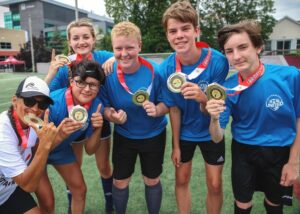Coaches looking for Indigenous soccer talent for 2023 NAIG Summer Games

By Laura E. Young
SUDBURY – Long before Team Ontario ever scores a goal at the North American Indigenous Games this July, they need to field a team.
Indeed, that is the goal for Team Ontario as the soccer coaches recruit to field four teams: girls and boys U16 and U19 females and males, for at least 48 players, at a minimum of 12 per team.
Shouldn’t be so hard, considering soccer’s popularity.
At the Nov. 5 Indigenous soccer tryouts in Sudbury, numbers were good but they had to combine the girls and boys to have enough players to scrimmage, says Ghislaine Goudreau, the female team coach who is also member of the Algonquins of Pikwàkanagàn First Nation.
“I even recruited athletes from the basketball tryouts as they always have high numbers,” Goudreau says. “I continue to encourage athletes to try out for more than just one sport as there is only a limited number of spots on the more popular sporting teams. Come try soccer. What do you have to lose?”
The 10th North American Indigenous Games (NAIG) will be held July 15-18, 2023. They’re for youth aged 13-19 and bring together an estimated 5,000 athletes. The games will be held in Kjipuktuk (Halifax), Dartmouth, and Millbrook First Nation in Nova Scotia, with the host Mi’kmaq people.
It remains a mystery as to why there are issues recruiting soccer players, says Goudreau. The retired national-level ringette player, who has also played hockey and soccer, teaches Indigenous Studies at Cambrian College.
“I just want to be someone who could motivate and inspire [people] to do great things. I feel we have awesome athletes. I don’t want to leave them not having a team.”
In past games, Ontario has not fielded full soccer teams.
It’s not about winning NAIG 2023, but about building capacity for future games.
“A team is my goal. Let’s build so that maybe 10 years down the road we beat the team from B.C.,” she says.
The issue is may be that the Indigenous players are picking other sports, she adds.
“In the North, there’s keen interest in volleyball and basketball. In a lot of communities, there’s an interest in baseball. In southern communities, there’s interest in lacrosse. Soccer is not necessarily on the radar and I’m trying to figure out why.”
There’s growth in soccer with the success of the national men’s and women’s team, she says.
“I’ve seen a growth locally. There are Indigenous kids who play. Maybe they’re not lasting and finding other sports when they get into high school.”
Every province and territory take a different approach to recruiting, says Clay Melnike, senior manager of special projects ISWO.
Tryouts and recruiting are expected to continue into April across the 15 sports, he says. Currently, seven more in-person tryouts are scheduled for the province through Indigenous Sport & Wellness Ontario (ISWO). This is the designated Provincial Territorial Aboriginal Sports Body (PTASB), sanctioned by the Aboriginal Sports Council (ASC) and the NAIG Council, to select, coordinate and manage Ontario’s participation at NAIG.
In Ontario, a mixed approach to recruiting is taking place so far. Over the years, “we’re getting a little smarter,” he says.
At tryouts, everyone wants to be on the basketball and volleyball teams, he says.
“We’re crossing over much better than we have in the past.”
Taking the best of the COVID-19 pandemic lessons, Melnike says they are also turning to virtual tryouts this winter. The athlete can send in videos of themselves playing or doing skills to the respective coaches.
As for the future of Ontario sport for Indigenous athletes, Ontario may need to take a different approach, says Melnike.
He wonders if more of an integrated approach with Ontario sport organizations is a solution.
“There are enough athletes to build [soccer] teams but they can’t build multiple teams and play [each other] on a regular basis.”
The size of Ontario also affects sport selection and tryouts. There are enough players but they’re spread out, he says.
Another hindrance may simply be awareness of the games or that they don’t have an easy jumping onto point with the NAIG sports stream.
The virtual approach will be one avenue where they can meet with coaches and talk and connect.
“To be part of a NAIG. I think it builds confidence and motivation.”
More information is posted on their website. (https://iswo.ca/naig-2023/) Tryouts are open to Indigenous youth, ages 13 to 19, who live in Ontario.


